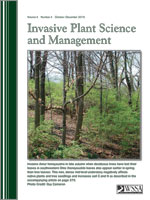Tall buttercup is an invasive forb that has been reported in all but eight states and one Canadian province. The species has been of concern in Montana where it has invaded over 8,300 ha, and it has been particularly problematic in irrigated hayfield meadows that are used for forage production. This study sought to develop an integrated management strategy to control tall buttercup while maintaining forage production. Research was conducted over 2 yr at flood-irrigated and subirrigated hayfield meadows near Twin Bridges, MT. Treatments were randomly applied in a split-plot design with four replications at both sites. Herbicide treatments occurred at the whole-plot level: nonsprayed, aminopyralid (172 g ai ha−1), aminocyclopyrachlor chlorsulfuron (83 g ai ha−1 33 g ai ha−1), and dicamba (981 g ai ha−1). Split plots consisted of mowing and fertilization (28 kg N ha−1). All herbicides provided up to 2 yr of tall buttercup control at both sites. In the second year, aminocyclopyrachlor chlorsulfuron and aminopyralid reduced tall buttercup by 93% and 96%, respectively, for the subirrigated and flood-irrigated sites. At the subirrigated site, mowing reduced tall buttercup by 71%, and fertilization reduced it by 57%. Forage decreased following aminocyclopyrachlor chlorsulfuron treatments. The integration of herbicide, mowing, and fertilization did not improve tall buttercup control.
Nomenclature: Aminocyclopyrachlor; aminopyralid; chlorsulfuron; dicamba; tall buttercup, Ranunculus acris L. RANAC.
Management Implications: Tall buttercup has been a problematic invader in New Zealand for many years. In North America the species has recently been of concern, especially in Montana where it is believed to reduce forage production in hayfield meadows. However, there are no published studies on tall buttercup management in North America, and landowners have little guidance about how to control the species, while maintaining productivity and plant diversity. In this study, we sought to develop an integrated management strategy to control tall buttercup while encouraging the growth of desirable forage plants, including perennial grasses and clovers. We used two study sites, one in a subirrigated hayfield and a second in a flood-irrigated hayfield in western Montana. We tested four herbicide treatments, including nonsprayed, aminopyralid (172 g ai ha−1), aminocyclopyrachlor chlorsulfuron (83 g ai ha−1 33 g ai ha−1), and dicamba (981 g ai ha−1), mowing, and fertilization (28 kg N ha−1), applied individually and in all possible combinations. Aminopyralid and aminocyclopyrachlor chlorsulfuron most effectively reduced tall buttercup biomass. Dicamba also reduced tall buttercup compared to the nonsprayed treatment, but was not as effective as the other two herbicides. At the subirrigated site, mowing and fertilization used individually reduced tall buttercup. However, mowing or fertilization at the flood-irrigated site did not reduce tall buttercup, and their combination did not provide control at either site. Moreover, the integration of herbicides with mowing and fertilization did not improve tall buttercup control. Aminocyclopyrachlor chlorsulfuron reduced perennial grasses at both sites, and all herbicides reduced clover, an important forage component of hayfield meadows, compared to nonsprayed plots across both sites. Although combinations of mowing and fertilization with or without herbicides did not improve control of tall buttercup over the use of herbicides alone, long-term integrated management can reduce selection pressure that could lead to herbicide resistance.





